Predictions & Data for this entry
| Model: std | climate: C | migrate: | phylum: |
| COMPLETE = 2.5 | ecozone: TP, TN, TA, TH | food: biD | class: |
| MRE = 0.135 | habitat: 0iTh, 0iTf, 0iTi | gender: Hh | order: |
| SMSE = 0.043 | embryo: Tt | reprod: O | family: |
Zero-variate data
| Data | Observed | Predicted | (RE) | Unit | Description | Reference |
|---|---|---|---|---|---|---|
| ab | 25 | 14.51 | (0.4196) | d | age at birth | CEH2016 |
| tp | 60 | 61.72 | (0.02863) | d | time since birth at puberty | CEH2016 |
| am | 1825 | 1825 | (2.361e-05) | d | life span | CEH2016 |
| Lb | 1 | 1.343 | (0.3432) | cm | length at birth | CEH2016 |
| Lp | 5 | 4.462 | (0.1077) | cm | length at puberty | CEH2016 |
| Li | 8 | 6.776 | (0.153) | cm | ultimate total length | CEH2016 |
| Wwb | 0.015 | 0.01666 | (0.1106) | g | wet weight at birth | ReinVent1987 |
| Wwp | 0.6 | 0.6105 | (0.01756) | g | wet weight at puberty | ReinVil1990 |
| Wwi | 2.4 | 2.139 | (0.1087) | g | ultimate wet weight | Neuh1980 |
| Ri | 0.8871 | 0.9096 | (0.02534) | #/d | maximum reprod rate | CEH2016 |
Uni- and bivariate data
| Data | Figure | Independent variable | Dependent variable | (RE) | Reference |
|---|---|---|---|---|---|
| tW1 | 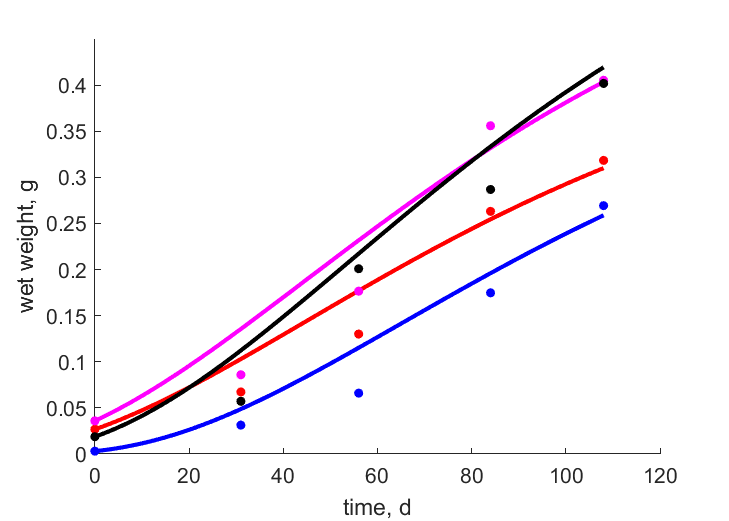 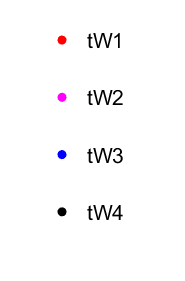 | time | wet weight | (0.1238) | CEH2016 |
| tW2 |   | time | wet weight | (0.1235) | CEH2016 |
| tW3 |   | time | wet weight | (0.1809) | CEH2016 |
| tW4 |   | time | wet weight | (0.1405) | CEH2016 |
| tW5 | 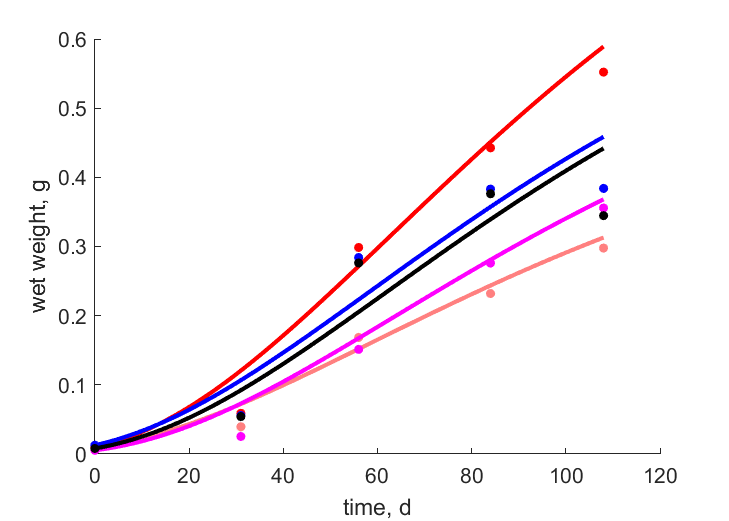  | time | wet weight | (0.1025) | CEH2016 |
| tW6 |   | time | wet weight | (0.0986) | CEH2016 |
| tW7 |   | time | wet weight | (0.09955) | CEH2016 |
| tW8 |   | time | wet weight | (0.1896) | CEH2016 |
| tW9 |   | time | wet weight | (0.2297) | CEH2016 |
| tW21 | 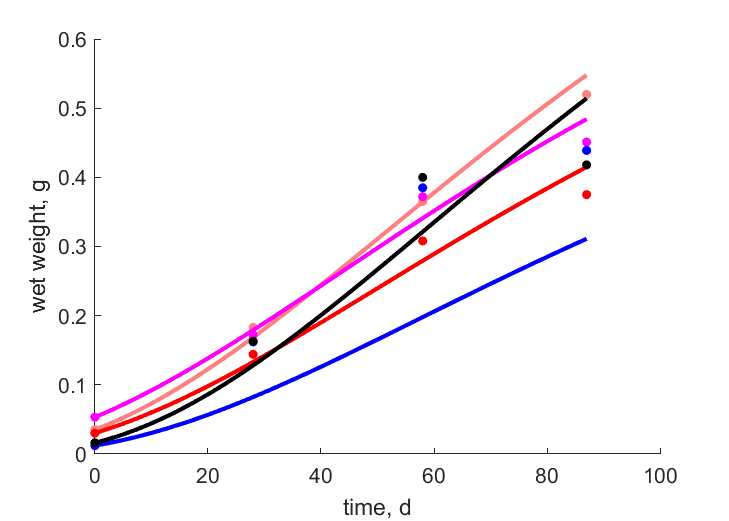 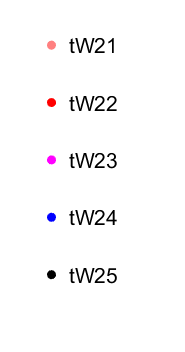 | time | wet weight | (0.03887) | CEH2016 |
| tW22 |   | time | wet weight | (0.09289) | CEH2016 |
| tW23 |   | time | wet weight | (0.06809) | CEH2016 |
| tW24 |   | time | wet weight | (0.3958) | CEH2016 |
| tW25 |   | time | wet weight | (0.2106) | CEH2016 |
| tW26 | 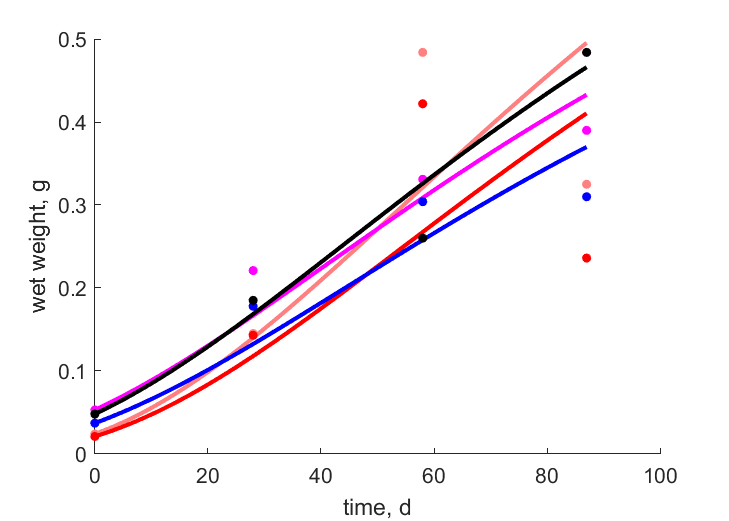  | time | wet weight | (0.346) | CEH2016 |
| tW27 |   | time | wet weight | (0.4309) | CEH2016 |
| tW28 |   | time | wet weight | (0.1201) | CEH2016 |
| tW29 |   | time | wet weight | (0.1831) | CEH2016 |
| tW210 |   | time | wet weight | (0.1025) | CEH2016 |
| tW211 |  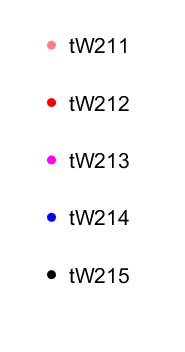 | time | wet weight | (0.08291) | CEH2016 |
| tW212 |   | time | wet weight | (0.1556) | CEH2016 |
| tW213 |   | time | wet weight | (0.1317) | CEH2016 |
| tW214 |   | time | wet weight | (0.2061) | CEH2016 |
| tW215 |   | time | wet weight | (0.1633) | CEH2016 |
| tW216 | 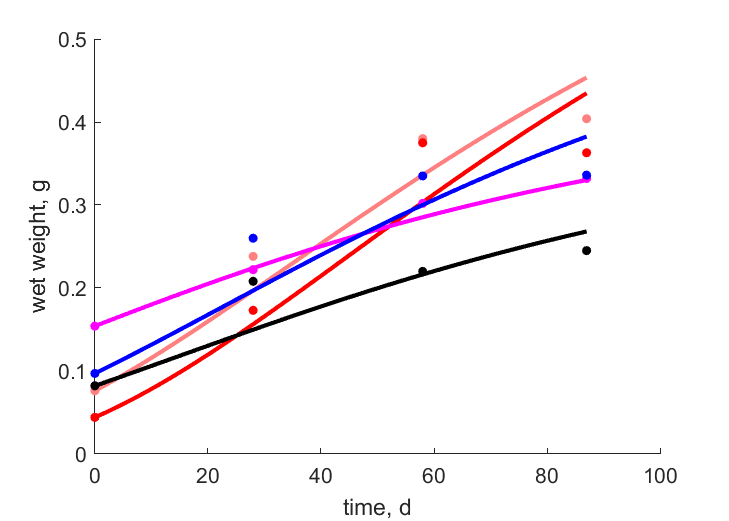 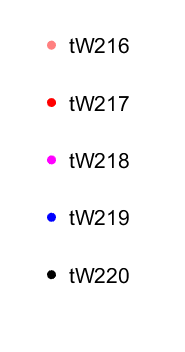 | time | wet weight | (0.1225) | CEH2016 |
| tW217 |   | time | wet weight | (0.1677) | CEH2016 |
| tW218 |   | time | wet weight | (0.02033) | CEH2016 |
| tW219 |   | time | wet weight | (0.1407) | CEH2016 |
| tW220 |   | time | wet weight | (0.1127) | CEH2016 |
| tW221 | 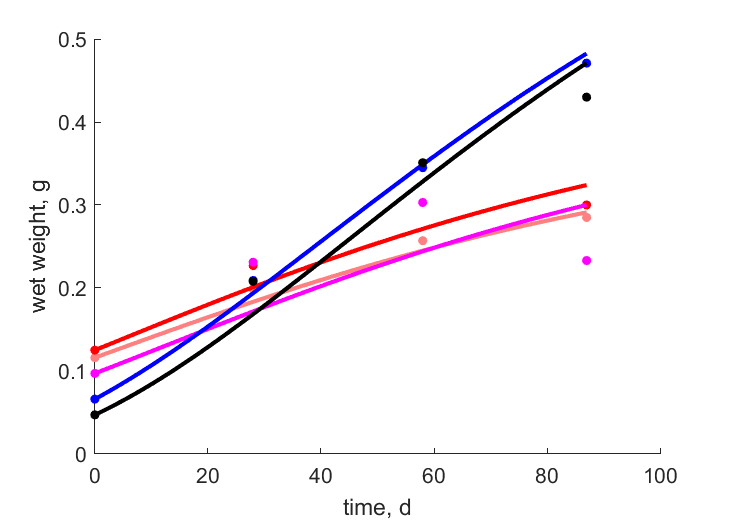  | time | wet weight | (0.03956) | CEH2016 |
| tW222 |   | time | wet weight | (0.08575) | CEH2016 |
| tW223 |   | time | wet weight | (0.2144) | CEH2016 |
| tW224 |   | time | wet weight | (0.02803) | CEH2016 |
| tW225 |   | time | wet weight | (0.09989) | CEH2016 |
| tW226 |  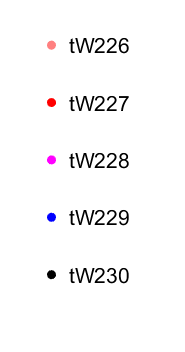 | time | wet weight | (0.0536) | CEH2016 |
| tW227 |   | time | wet weight | (0.03447) | CEH2016 |
| tW228 |   | time | wet weight | (0.06937) | CEH2016 |
| tW229 |   | time | wet weight | (0.1929) | CEH2016 |
| tW230 |   | time | wet weight | (0.07526) | CEH2016 |
| tW231 | 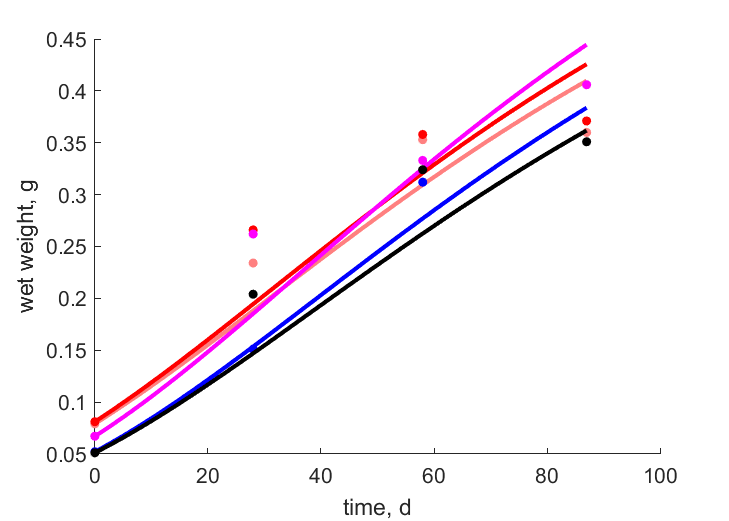 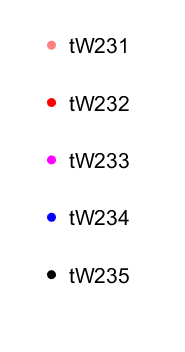 | time | wet weight | (0.1357) | CEH2016 |
| tW232 |   | time | wet weight | (0.1519) | CEH2016 |
| tW233 |   | time | wet weight | (0.1155) | CEH2016 |
| tW234 |   | time | wet weight | (0.08109) | CEH2016 |
| tW235 |   | time | wet weight | (0.1393) | CEH2016 |
| tW236 | 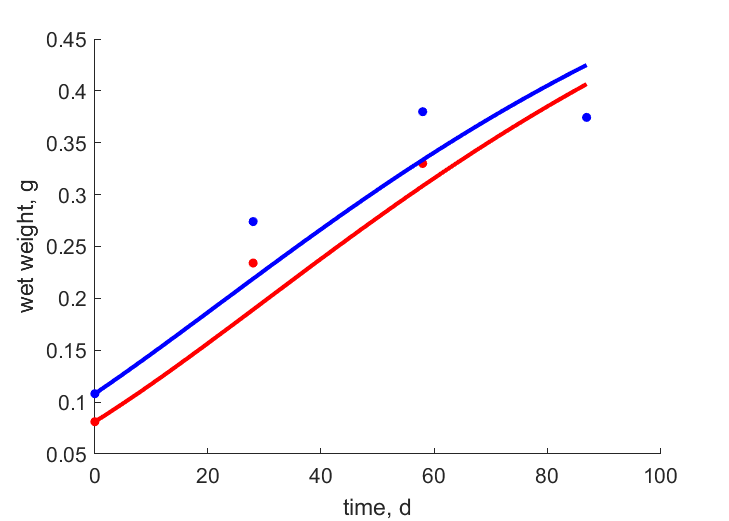 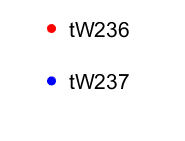 | time | wet weight | (0.09669) | CEH2016 |
| tW237 |   | time | wet weight | (0.1338) | CEH2016 |
| tW10 | 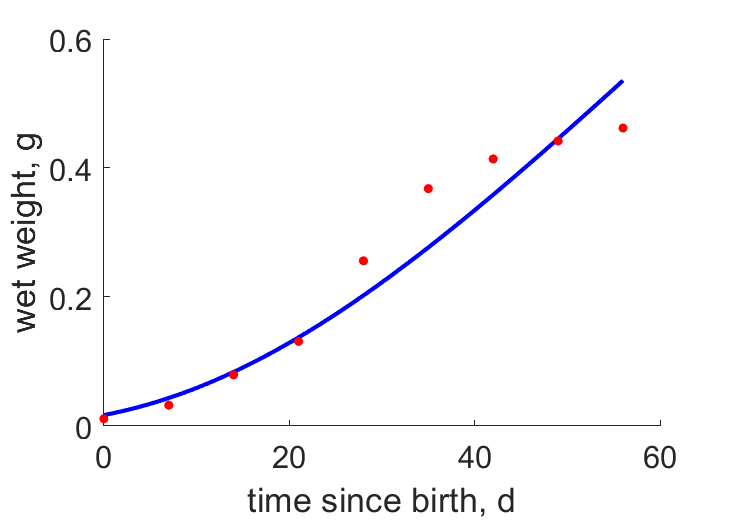 | time since birth | wet weight | (0.139) | Guna2002 |
| tW11 |  | time since birth | wet weight | (0.1243) | Neuh1980 |
| tW12 | 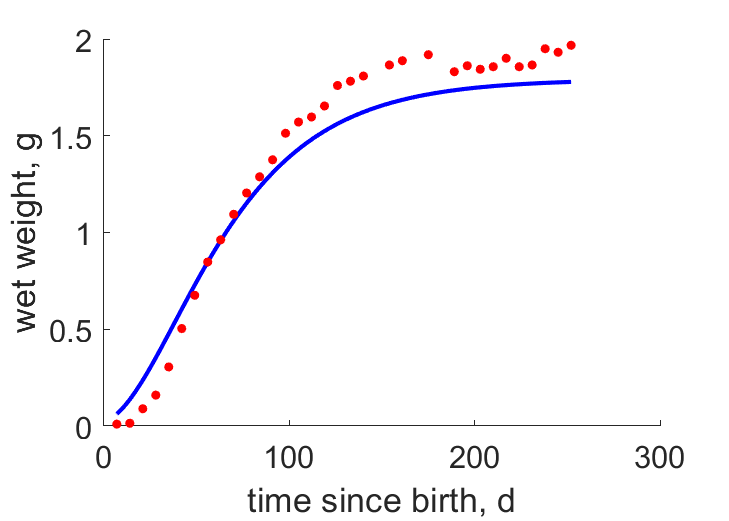 | time since birth | wet weight | (0.08968) | Neuh1980 |
| tW13 | 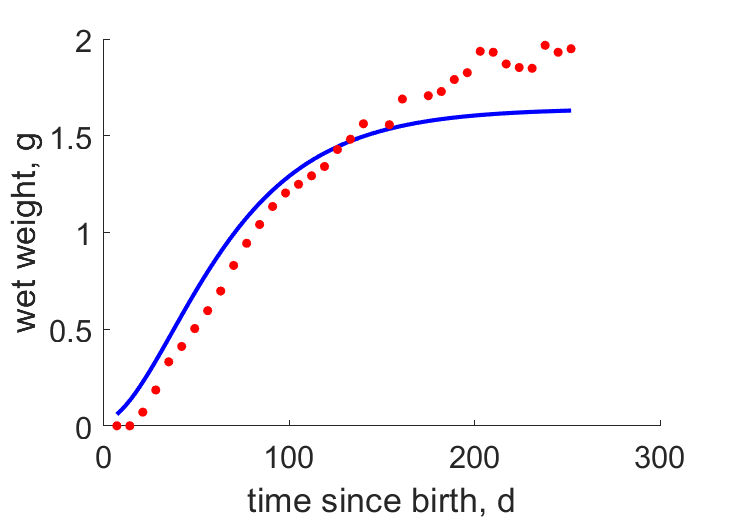 | time since birth | wet weight | (0.1296) | Neuh1980 |
Pseudo-data at Tref = 20°C
| Data | Generalised animal | Eisenia fetida | Unit | Description |
|---|---|---|---|---|
| v | 0.02 | 0.01477 | cm/d | energy conductance |
| kap | 0.8 | 0.5756 | - | allocation fraction to soma |
| kap_R | 0.95 | 0.475 | - | reproduction efficiency |
| p_M | 18 | 4741 | J/d.cm^3 | vol-spec som maint |
| k_J | 0.002 | 0.002 | 1/d | maturity maint rate coefficient |
| kap_G | 0.8 | 0.8004 | - | growth efficiency |
Discussion
- We assume kap_R 0 0.95/2 for consistency with how all hermaphrodites are treated in the collection
- The mod_1 included more weight against time since birth data.
Facts
- Eisenia fetida is hermaphroditic. However, two worms are still required for reproduction. (Ref: Wiki)
Acknowledgment
- The creation of this entry was supported by the European Food Safety Authority (grant number OC/EFSA/SCER/2015/01)
Bibliography